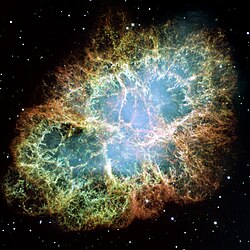Portal:Astronomia/Artykuł miesiąca 01 2019
Astronomia (gr. ἀστρονομία astronomía) – nauka przyrodnicza zajmująca się badaniem ciał niebieskich (np. gwiazd, planet, komet, mgławic, gromad i galaktyk) oraz zjawisk, które zachodzą poza Ziemią, jak również tych, które oddziałują w jej atmosferze, wnętrzu lub na powierzchni, a są pochodzenia pozaplanetarnego (np. neutrina, wtórne promieniowanie kosmiczne). Skoncentrowana jest na fizyce, chemii, meteorologii i ruchu ciał niebieskich, zajmuje się także powstaniem i rozwojem (ewolucją) Wszechświata.
Astronomia jest jedną z najstarszych nauk. Kultury prehistoryczne pozostawiły astronomiczne artefakty, takie jak egipskie piramidy, czy Stonehenge. Cywilizacje, takie jak: Babilończycy, Grecy, Chińczycy, Hindusi i Majowie wykonywali metodyczne obserwacje nocnego nieba. Jednakże dopiero wynalezienie teleskopu sprawiło, że astronomia była w stanie przekształcić się w nowoczesną naukę. Historycznie w astronomię włączano tak różne dyscypliny, jak astrometria, astronawigacja, astronomia obserwacyjna, tworzenie kalendarzy, a nawet astrologia. Obecnie pojęcie profesjonalnej astronomii jest niemal tożsame z pojęciem astrofizyki.
Media użyte na tej stronie
This is a mosaic image, one of the largest ever taken by NASA's Hubble Space Telescope, of the Crab Nebula, a six-light-year-wide expanding remnant of a star's supernova explosion. Japanese and Chinese astronomers recorded this violent event in 1054 CE, as did, almost certainly, Native Americans.
The orange filaments are the tattered remains of the star and consist mostly of hydrogen. The rapidly spinning neutron star embedded in the center of the nebula is the dynamo powering the nebula's eerie interior bluish glow. The blue light comes from electrons whirling at nearly the speed of light around magnetic field lines from the neutron star. The neutron star, like a lighthouse, ejects twin beams of radiation that appear to pulse 30 times a second due to the neutron star's rotation. A neutron star is the crushed ultra-dense core of the exploded star.
The Crab Nebula derived its name from its appearance in a drawing made by Irish astronomer Lord Rosse in 1844, using a 36-inch telescope. When viewed by Hubble, as well as by large ground-based telescopes such as the European Southern Observatory's Very Large Telescope, the Crab Nebula takes on a more detailed appearance that yields clues into the spectacular demise of a star, 6,500 light-years away.
The newly composed image was assembled from 24 individual Wide Field and Planetary Camera 2 exposures taken in October 1999, January 2000, and December 2000. The colors in the image indicate the different elements that were expelled during the explosion. Blue in the filaments in the outer part of the nebula represents neutral oxygen, green is singly-ionized sulfur, and red indicates doubly-ionized oxygen.
